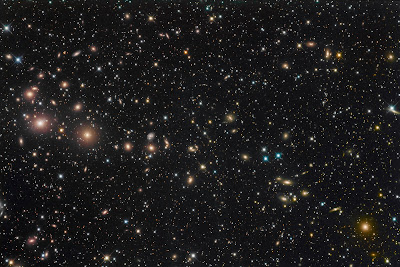about 250 million light years away lives a giant city of galaxies called the perseus cluster (because it lives in the direction of the constellation perseus, but it is also known as abell 426 by most astronomers). the perseus cluster is made up of thousands of galaxies that are all stuck together by gravity.
this is one of the largest objects that any human will see across our sky and is one of the closest galaxy clusters to us in the universe. cool, right!?!
let's start with the widest view of the perseus cluster. most of those fuzzy blobs are individual galaxies that contain hundreds of billions of stars each.
at the very heart of the cluster, at the gravitational center, lives an active galaxy called NGC 1275. in the above image, NGC 1275 is at the far left-center. below is a closer look at the cluster. can you identify NGC 1275 by the detailed muck surrounding it? it almost looks like a galaxy firework ;)
here is an image from the hubble space telescope of NGC 1275, which is one of the closest giant elliptical galaxies to us.
in the above image you can see thin threads of red reaching out and surrounding the galaxy. these filaments are cold gas suspended around the galaxy by a magnetic field.
the red filaments show evidence of how the super massive black hole that lives at the core of the galaxy interacts with its surroundings. the filaments form when the black hole transports energy outward in the form of radio bubbles. you can see these in the below image, which again shows NGC 1275, but includes the radio (pink) and X-ray (purple) data.
when the black hole bubbles its energy outward, it pushes out hot X-ray gas (shown in the surrounding purple regions) and leaves cavities that produce radio lobes - you can see two large pink radio lobes roughly to the north and south the bright galaxy center.
the hot gas first cools as it sends off x-rays and then by mixing with the outer cold gas. as the gas cools, it congregates in filaments and starts sinking back towards the center, until the next episode of black hole bubbles commences.
at the galaxy fireworks meeting a few weeks ago on hamilton island, andy fabian gave an excellent talk showing evidence that the super massive black hole in massive galaxies continously inputs energy into the surrounding gas, like the bubbles that rise from a filter placed in an aquarium. it is unclear how this process can keep working over several billion years, but this scenario matches the observations much better than having just a few, isolated black hole feedback events.
this is one of the largest objects that any human will see across our sky and is one of the closest galaxy clusters to us in the universe. cool, right!?!
let's start with the widest view of the perseus cluster. most of those fuzzy blobs are individual galaxies that contain hundreds of billions of stars each.
 |
| The Perseus Cluster (Credit: Bob Franke) |
here is an image from the hubble space telescope of NGC 1275, which is one of the closest giant elliptical galaxies to us.
 |
| Giant Galaxies NGC 1275 and its filaments of gas (Credit: NASA/ESA) |
the red filaments show evidence of how the super massive black hole that lives at the core of the galaxy interacts with its surroundings. the filaments form when the black hole transports energy outward in the form of radio bubbles. you can see these in the below image, which again shows NGC 1275, but includes the radio (pink) and X-ray (purple) data.
 |
| NGC 1275 with Xray and radio data (Credit: NASA/ESA) |
the hot gas first cools as it sends off x-rays and then by mixing with the outer cold gas. as the gas cools, it congregates in filaments and starts sinking back towards the center, until the next episode of black hole bubbles commences.
at the galaxy fireworks meeting a few weeks ago on hamilton island, andy fabian gave an excellent talk showing evidence that the super massive black hole in massive galaxies continously inputs energy into the surrounding gas, like the bubbles that rise from a filter placed in an aquarium. it is unclear how this process can keep working over several billion years, but this scenario matches the observations much better than having just a few, isolated black hole feedback events.

No comments:
Post a Comment